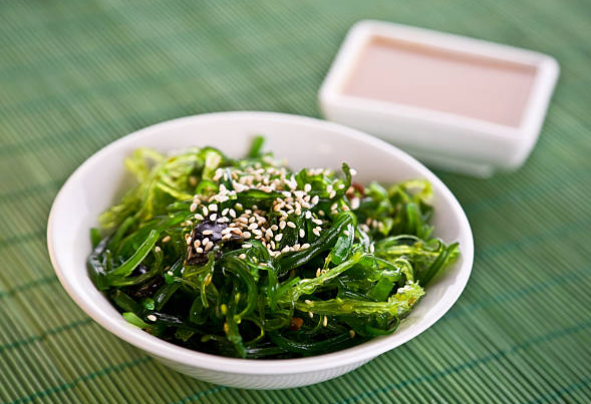Seaweed value added products in food industry & pharmaceuticals

In this article, we will discuss seaweed value-added products in the food industry and pharmaceuticals, opening up innovative possibilities. Seaweed’s diverse applications in creating nutritional supplements, flavor enhancers, and pharmaceutical compounds showcase its potential to contribute to both the culinary and medical fields, offering unique benefits and sustainable solutions.
Seaweed in the food industry
- Seaweed nutri drink:
Seaweed Nutridrink contains seaweed (Sargassum wightii) and grape juice. The drink is rich in fucoidan, which has established health benefits. The technology resulted in the valuable addition of fruit juices and the high-value utilization of seaweeds. The Nutridrink is also a source of bioactive carotenoid fucoxanthin and seaweed polyphenols. A 20% blend of seaweed extract with grape juice was microencapsulated, resulting in a reconstitutable powder. The Nutridrink possesses a significantly higher amount of Riboflavin and Pantothenic acid and appreciable quantities of Taurine, a free amino acid with known nutraceutical properties.
- Cookies:
Caulerpa racemosa, commonly known as sea grapes, is a green seaweed with various physiological benefits. Seaweed is one of the healthful foods traditionally consumed by coastal populations. This seaweed is a good source of essential minerals like calcium, iron, and magnesium, and natural antioxidants. In traditional and folk medicine, Caulerpa is widely known to treat high blood pressure and rheumatism. Cookies with Caulerpa racemosa as an ingredient offer a unique and innovative approach toward utilizing seaweed as a functional food.
The cookies are rich in protein, dietary fiber, and high phenolic content and antioxidative potential. Seaweed cookies provide the option for market diversification of seaweed in the form of a healthy biscuit. The technology is aimed at the global healthy biscuit market, valued at 2.2 billion US$ and expected to grow at an annual rate of 5% between 2019 and 2025.
- Yogurt:
Sargassum wightii, a brown seaweed, is rich in fucoidan, a fucose-rich sulfated polysaccharide with various physiological properties. It has potential applications in the formulation of functional and nutraceutical products. Fucoidan possesses several bioactivities, i.e., anti-cancer, anti-thrombotic, antivirus, antioxidant, anti-inflammatory, anti-diabetic, and near dietary fiber, actively extracted from Sargassum wightii using a novel ultrasonication-assisted extraction procedure and is supplemented in the yogurt formulation.
The extract is completely biocompatible, as proven in in vitro and in vivo studies. No harmful organic solvent is used for extraction. Fucoidan-enriched yogurt exhibits good phenolic content and antioxidative potential. The enrichment with fu has a minimal effect on the sensory characteristics of yogurt. Seaweed yogurt has got high acceptance among consumers. Yogurt is an efficient delivery system for seaweed’s physiological benefits in the human diet. The technology is aimed at the global fortified yogurt market, which is expected to garner a revenue of US$ 10 billion by 2024, with an annual growth rate of approximately 6.5%.
- Seaweed edible sachet:
Seaweeds are rich in proteins, dietary fiber, polysaccharides, vitamins, minerals, and critical bioactive compounds. The edible and biodegradable sachet/film developed from seaweed is a novel food packaging solution. Seaweeds such as Kappaphycus alvarezii and Ulva reticulata are Essential bioresources for hydrocolloid extraction. A technology has been developed to prepare edible and functional sachet using these seaweeds. The sachets are cast using the film casting method. The film-forming solution is obtained by dissolving seaweed powder of U. reticulata and K. alvarezii, using sodium alginate and sorbitol as the plasticizer. The homogenized solutions were finally cast as a film.
Seaweed-based functional and edible films exhibit good sealing and antioxidant properties. Therefore, the novel packaging material can be used as soluble sachets/ pouches/bags for seasonings in instant noodles and for packing instant coffee/ tea, etc., in the food industry. The seaweed-based packaging sachet adds up the nutritional and functional value of the food product by acting as an antioxidant and antimicrobial agent, thereby improving the quality and preservation of food. The technology is intended to reduce the use of plastic in ready-to-eat food packaging, thereby reducing solid waste generation.
- Seaweed-based packing materials:
Most modern-day packaging materials are composed of fossil-based polymers, which are hazardous to the environment. Biopolymers provide an excellent alternative to petroleum-derived polymers, being eco-friendly, non-toxic, and renewable. Though biopolymer-based films can be prepared from proteins, carbohydrates, and lipids, carbohydrate-based films are the most preferred because of their colloidal properties and better film-forming ability. Seaweed extract-based packaging materials are prepared from the polysaccharide of the red seaweed Gracilaria edulis and Gelidiella acerosa and brown seaweed Sargassum wightii. The seaweed-based bioplastics exhibit good physical, thermal, and barrier properties and are ideal for packing various food products. These bioplastics are biodegradable, eco-friendly, naturally available, renewable and cheaper. The products serve as an alternative to petroleum-based plastics. The packaging materials can be prepared with fish protein/ antioxidants /natural antimicrobial agents/flavoring additives to make them edible and bio-functional.
Conclusion
Seaweed, by its abundance in the Indian coastal line, has a big industry in the days to come where it can create employment, generate income, and act as a great alternative to plastic and hazardous materials. Entrepreneurs have an excellent opportunity to establish a seaweed-based industry and can produce the products mentioned in the article. ICAR–CIFT has taken the initiative to produce these products and encourage India’s small-scale farmers to cultivate seaweed.
References:
BOOK – ICAR Technologies: High-Value Nutraceutical and Nutritional Products from Seaweeds Editors: A. Gopalakrishnan, C. N. Ravishankar, Pravin, J.K. Jena
Christiana Jones
Student at SR University, School of Agriculture.Dedicated and enthusiastic professional student who is an Applied academic interested and passionate about research and development. I thrive in the unknown, fueled by a relentless passion to uncover, create, and push the boundaries of knowledge in the field of Agriculture. Very glad to be a part of Wikifarmer\'s Library as a contributor author to share the knowledge about farming across the globe.
Join our editorial team
Join our community and contribute to Wikifarmer, a platform based on the knowledge of a diverse community of farmers and people working in the agricultural industry from all over the world.









































































